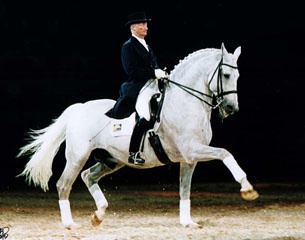
Since the invention of the dressage World Cup in the mid 1980s there has been a couple of crowd-pleasers among the horses. One of them was undoubtedly the grey stallion Aktion who was an unforgettable appearance on the international scene for over a decade and the uncrowned king of the kur in a record number of World Cup finals. He made his Hungarian rider famous and was the torch-bearer for Hungarian dressage.
Hungary has a long tradition of breeding quality horses like the Gidran, the Kisberian, the Nonius and the Furioso North Star. But the country surprisingly had rather more success in international driving than other equestrian discipline before Gyula Dallos found a diamond in the rough in Switzerland.
Dallos is a professional dressage rider and trainer and had already competed internationally on a horse called Bordal. By the end of the 1980s when the iron curtain fell he was scouting for horses for Mr. Alexander Moksel. In 1989 he traveled to Switzerland to look for horses in the stable of Swiss Olympic rider and well known horse dealer Daniel Ramseier. There he met the horse of a life-time: „I was captured by his movement and imposing exterior at first sight!“
Aktion was a Dutch bred horse and born on 5th May 1982. Sired by the famous Pion (an Abgar xx-son and an international show jumper) out of the mare Ohnegliechen by Akteur he was bred by Berend Ridder from Harkstede, Holland. His pedigree included ¾ Gelderland and Groninger blood, the traditional Dutch breeds, and ¼ thoroughbred.
When Dallos found Aktion he was barely 7 years and hadn't been competed. Alexander Moksel bought the promising stallion for the Hungarian to train and compete. It was a great chance for Dallos, but like so often also this partnership had to be earned.
"It was not easy to worm my way into Aktion's confidence," Dallos admitted. "Not in the stable, nor in the arena. There were great difficulties to ride him and to communicate with him because Aktion wanted to dominate in every single situation. The crisis took four months and caused many sleepless nights, but I always had faith that we would find each other. The assiduous calmness, love and consistency yielded its fruits – he got to like and accept me.“
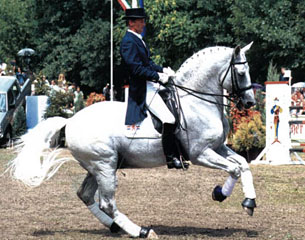 Aktion turned out to be a one person's horse who was even chasing foreigners out of his stable if necessary. As soon as he had found his master in Gyula Aktion's unique intelligence and talent, of which he was fully aware, worked in his rider's favour day by day.
Aktion turned out to be a one person's horse who was even chasing foreigners out of his stable if necessary. As soon as he had found his master in Gyula Aktion's unique intelligence and talent, of which he was fully aware, worked in his rider's favour day by day.
How much Aktion was focused on Dallos is shown by the fact that he often spent parts of his day watching him train other horses: "He hearkened from the window of his box and could not take his eyes off me for long hours."
Quite early after the grey had moved in his stall at Dallos' property both started their first show together, an L-dressage test in Nagycenk in Hungary. They finished as one of the last and following this Dallos decided just to go on with the stallion's training, but not to compete him for a while.
Dallos acknowledge there were no difficulties in Aktion's training because he was such a unique talent. The grey's square conformation enabled him to show a kind of high collection which usually only breeds like the Lipizzan are able to. Movements like the canter pirouettes, passage and piaffe, which became Aktion's hallmark later, he learned easily or like his rider expressed it: "They were invented just for him!"
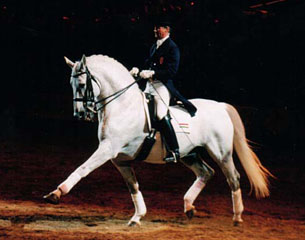 Gyula Dallos' training follows the classical principles based on gymnastics. Thereby he uses a varying training system which includes lunging, loose jumping, cavaletti work and hacking out. Aktion also used to be trained on the race track regularly. This kind of training may have been one decisive factor why the heavy bodied horse with its solid conformation had one of the longest lasting and successful careers in the history of dressage. Another reason could have been Aktion's passion for performing: „He loved competitions and shows. The bigger the lights, the noise and the audience were, the more he loved to perform.“
Gyula Dallos' training follows the classical principles based on gymnastics. Thereby he uses a varying training system which includes lunging, loose jumping, cavaletti work and hacking out. Aktion also used to be trained on the race track regularly. This kind of training may have been one decisive factor why the heavy bodied horse with its solid conformation had one of the longest lasting and successful careers in the history of dressage. Another reason could have been Aktion's passion for performing: „He loved competitions and shows. The bigger the lights, the noise and the audience were, the more he loved to perform.“
In 1990 Dallos introduced Aktion to S-level dressage and he showed quite promising results. The step to Grand Prix, which some horses are never able to do, occurred only a year later when Aktion was 9 years old. It wasn't a big one for him. His strengths were the Grand Prix movements above all else. In the spring of 1991 Gyula Dallos and Aktion began a string of success at the highest level which will be unequalled in Hungary for a long time, if there will ever be a pair of similar class one day?
National and international judges alike accepted Aktion straight away and rated him highly from the beginning. The horse placed in the top 6 at the CDIs of Ksiaz and Kaposvar and 10th at Amsterdam. Then came the European Championships of Donaueschingen in September, where Aktion met the best horses. He stood the comparison brilliantly and his rider became the first Hungarian to qualify for the individual final of an international dressage championships. The pair finished remarkably 7th in the freestyle, in which 12 horses fought for the medals.
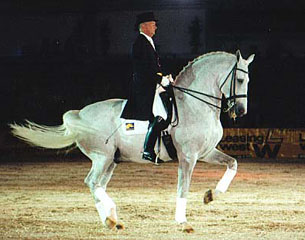 With his great appearance, his charm and his natural sense for showing off Aktion seemed to be the born freestyle horse. His talent and the impact he had on the crowds were obvious early on: "He was a noble athlete with a thick body, but more attractive than any ballerina."
With his great appearance, his charm and his natural sense for showing off Aktion seemed to be the born freestyle horse. His talent and the impact he had on the crowds were obvious early on: "He was a noble athlete with a thick body, but more attractive than any ballerina."
In 1992 Aktion qualified for his first of 6 World Cup finals, held at s'Hertogenbosch, and he placed 9th in a high quality field with upcoming Olympic medal winners like Grunox or Gifted. Aktion even came 2nd in the freestyle at the CDIO Aachen prior to the Olympics and hopes were high to give a good debut for Hungarian dressage at the Games in Barcelona.
Luckily the future of the pair had been secured already at the beginning of 1992 when the famous Bábolna Agricultural Combine had purchased the grey from Moksel. Unfortunately the Olympic dream never realised for the exceptional horse: Like the great tennis player Ivan Lendl never won Wimbledon, Aktion was never given a chance to enter the Olympic stage. "It was not up to us that Aktion could not participate in the Olympics. In Barcelona he was the only one who got ill with viral pneumonia. It was deeply shocking and incomprehensible for me. In Atlanta he was eliminated at the vet check after a hock flexion test," Dallos recalled the lows of their career. In between both Olympic Games was the most successful time of a horse that profited from an extraordinary health. Aktion was never ill, never had a colic or a day of lameness until the end.
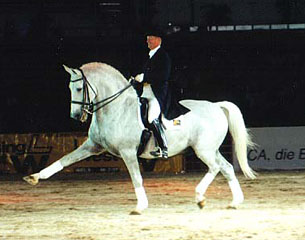 In 1993 Aktion placed in the top 3 at almost every CDI. Still it was a bit of surprise when the dapple grey won the first international medal in dressage for Hungary at the European Championships in Lipica, a show ground which had always suited Aktion very well, having won 9 times there in his career. Behind Nicole Uphoff and Sven Rothenberger Gyula Dallos won the bronze in the freestyle division and rated it as his most meaningful achievement: „With this medal we were able to put the Hungarian equestrian sport in a position.“
In 1993 Aktion placed in the top 3 at almost every CDI. Still it was a bit of surprise when the dapple grey won the first international medal in dressage for Hungary at the European Championships in Lipica, a show ground which had always suited Aktion very well, having won 9 times there in his career. Behind Nicole Uphoff and Sven Rothenberger Gyula Dallos won the bronze in the freestyle division and rated it as his most meaningful achievement: „With this medal we were able to put the Hungarian equestrian sport in a position.“
A year later the popular pair earned their highest placing in a World Cup final, ranking 5th in Gothenburg. They went on to win at the CDI shows at Ksiaz, Munich, Venice, Kaposvar, Lipica and Warsaw and slotted in 7th in the freestyle division at the WEG in The Hague.
Life of an international dressage horse from Hungary meant a lot of traveling for Aktion year after year. "His whole life was about traveling. Luckily he loved it. Aktion walked in the trailer by himself and was never against it. He was so reliable that he could even travel without a halter," his rider recalled.
The admirable stallion did not even lose faith when he faced a terrible lorry accident in 1995 while on his way to the CDI Ksiaz in Poland. Aktion and his companion Highlife were in the lorry when Dallos, his daughter Zsófia and their groom turned over on the highway in the Czech Republic. Their lorry slid 60 metres on its side with both horses inside. Dallos' daughter broke three vertebrae, the groom's leg cracked and Dallos injured his head as it broke the windscreen of his car. It was a miracle that the horses came away totally unscathed. "I made sure that my daughter would not be paralysed and was in the best hands. Then I rented a Czech lorry and drove to the competition where Aktion won the World Cup!"
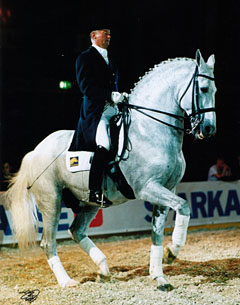 For Dallos this show was a turning point in his life: "If I had turned back then it might have been that I couldn't have competed anymore in my life. The show helped me to overcome this crisis."
For Dallos this show was a turning point in his life: "If I had turned back then it might have been that I couldn't have competed anymore in my life. The show helped me to overcome this crisis."
Aktion's marvelous attitude to his training and his hardship for long travels and competitions enabled him to continue his international career until the age of 18. Until then he had done two WEG, 5 European Championships and 6 World Cup finals and had been the declared crowd favourite wherever he appeared with his well known freestyle music. Aktion's fan club in Germany was large from the beginning and so the horse's official retirement was at the CDI Bremen in 2000, where he got a blanket embroidered with „Danke Aktion“.
Though one supposes Aktion and his rider must have been happy about this retirement after a career that spanned a decade, both weren't. "Aktion's natural element was performing and because he was healthy he demanded the daily work and never retired completely. His official international retirement happened basically because of pressure from the judges. Riding is a kind of technical sport and Aktion just got better as the years passed by. I could always improve his knowledge and movements. At 20 he was twice better than at 10—all video tapes prove this," Dallos reported, who was able to buy his partner in 2000.
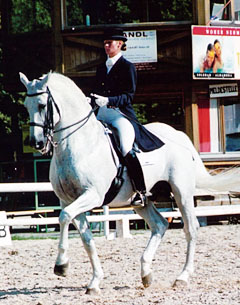 Aktion continued to compete at national level and at CDNs abroad until his death. He remained successfully, also with Dallos' young daughter Zsófia. His list of achievements is unbelievable: 154 victories in Grand Prix competitions, 11 in World Cup qualifiers and 11 times Hungarian Champion. n his last season Aktion won every show entered at the grand age of 20.
Aktion continued to compete at national level and at CDNs abroad until his death. He remained successfully, also with Dallos' young daughter Zsófia. His list of achievements is unbelievable: 154 victories in Grand Prix competitions, 11 in World Cup qualifiers and 11 times Hungarian Champion. n his last season Aktion won every show entered at the grand age of 20.
Simultaneously to his career in the show ring Aktion had similar success as a breeding stallion. Licensed by the KWPN as a 2 ½ year old he had covered early on with great success, producing winning horses for all three Olympic disciplines. The international dressage horses Finesse, Galliano, Falco and Feliki, all KWPN, were his early very successful progeny, sired in the 1980s.
Though Aktion has no KWPN licensed sons so far his name appears in the dam's line of successful breeding stallions. The quality mare Halla Utopia by Aktion is dam of Olivi (by Jazz), one of the young dressage sires of the KWPN. Olivi sired Matthias Alexander Rath's Grand Prix horse Triviant among others.
Aktion is approved for several international breeding associations and was proclaimed a keur preferent stallion at the 1999 KWPN stallion licensing. According to his rider Aktion has approximately 800 descendants to date and several of them were born at the renowned Kerteskö Stud in Hungary from thoroughbred mares which matched very well with his lines.
One product of these combinations is the bay gelding Akela (out of a thoroughbred dam by Imperiál xx), who was bred by Dr. Gábris Krisztina and was the best 6 year old Hungarian bred dressage horse, then ridden by Gyula Dallos. Akela is an international Grand Prix horse today with Dallos' former student, Simone Reissenweber.
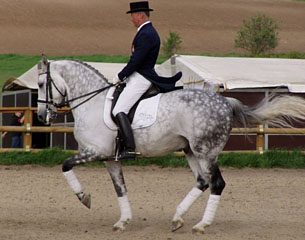 The spitting image of his father is Akvarel, a 1996 born Bavarian warmblood out of a Cor de Angelo- dam, bred by Herbert Keckeis in Germany. This lovely grey was produced by Gyula Dallos and won Grand Prix competitions with him before the horse was sold to the USA.
The spitting image of his father is Akvarel, a 1996 born Bavarian warmblood out of a Cor de Angelo- dam, bred by Herbert Keckeis in Germany. This lovely grey was produced by Gyula Dallos and won Grand Prix competitions with him before the horse was sold to the USA.
Asked what Gyula Dallos likes about the progeny of Aktion, he replied: „Of course I am not able to give an unbiased opinion on this topic as I loved Aktion to the extreme. But there's one thing I am sure in: Aktion's character and his abilities in flying changes, piaffe, passage and pirouette movements are dominantly inherited.“
Breeding never interfered with the stallion's competition duties as he was intelligent enough to differ both. For him it was always clear when he was expected to perform and when to breed: "Aktion was already 18 when he still had great success at the Vienna indoor show. His neighbour in the stable was a mare, but he did not make a sound. He knew what his task was and concentrated on the performance. Following this we took him to the clinic in Vienna to collect semen. Once we turned to the university Aktion was beside himself, neighing all the time," his rider reminisced.
Aktion, who had such a great impact on his rider and equestrian sport in Hungary, missed the joy of a long life when he was found ill in his stable in the morning on 2nd May 2003, shortly before he 21st birthday. Dallos' wife recalled that sad day: „After he had eaten the oats we gave him the hay, but he laid down and did not want to eat it. He was quiet, but his eyes were not clear. Within 15 minutes a vet looked at him and told us he had to go to the hospital immediately. An hour later Aktion was in the clinic and treated by the best vets. They diagnosed diverticulum duodeni and he was operated successfully. He was better afterwards and got 1000 litres of infusion, a lot of medicine and the vets did their very best for him. But after a week complications occurred and Aktion died.“
Aktion's death left a deep feeling of emptiness in the whole Dallos family as he had spent his last years in their home stable and had always been a close member of the family: "Aktion was my wonderful partner through foul and fair and we lived together with him, he was part of our family."
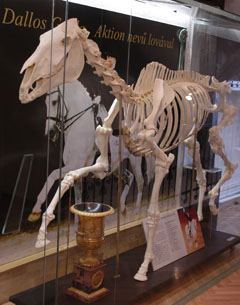 In honour of Aktion the Dallos family organised a farewell ceremony with presentations and films to the memory of their greatest horse ever in March 2004. Aktion's skeleton is exhibited in the Anatomy Museum of the Veterinary University of Budapest, showing him in passage. Behind it there is a life-sized picture of Dallos and Aktion in the same position.
In honour of Aktion the Dallos family organised a farewell ceremony with presentations and films to the memory of their greatest horse ever in March 2004. Aktion's skeleton is exhibited in the Anatomy Museum of the Veterinary University of Budapest, showing him in passage. Behind it there is a life-sized picture of Dallos and Aktion in the same position.
Aktion would have been a crowd pleaser with a rider of any nation in the saddle and nobody who saw him on TV or live will ever forget this kind of modern „Lipizzan“ who will always remain the „king of the kur“. But in this case Aktion also enabled a country like Hungary to play an important role in the upper dressage ranks for many years, which immortalizes him at the highest echelons.
Article by Silke Rottermann
Silke Rottermann likes to thank the Dallos family in their kind help in writing this article and for their contribution of the photographs.
Photos © Private, Gabriella Mitrov, Krisztina Hajdu
Related Links
Aktion promoted as "Keur"stallion
KWPN Foundation Stallion Aktion Passed Away